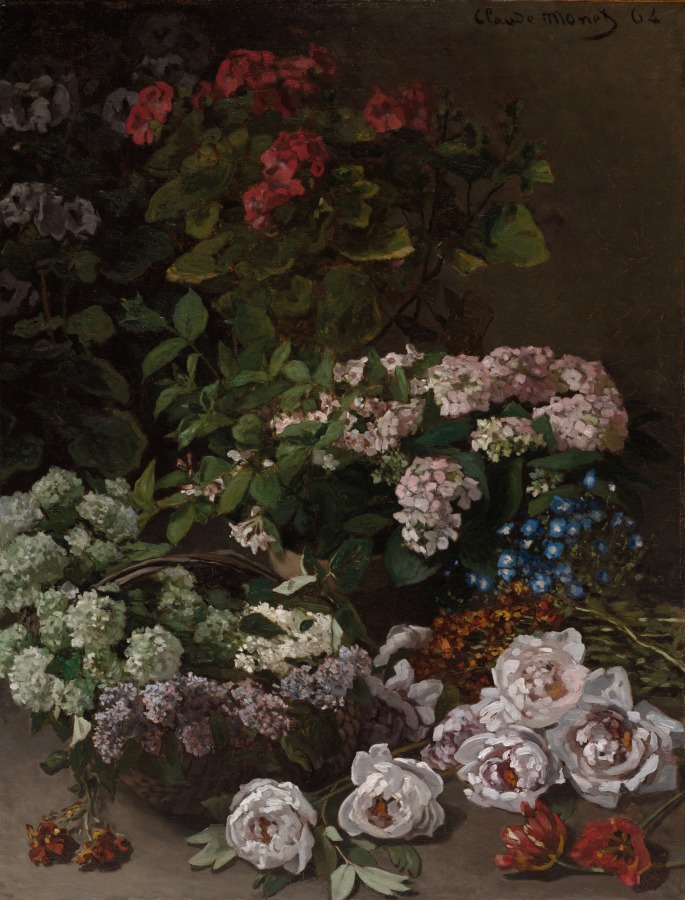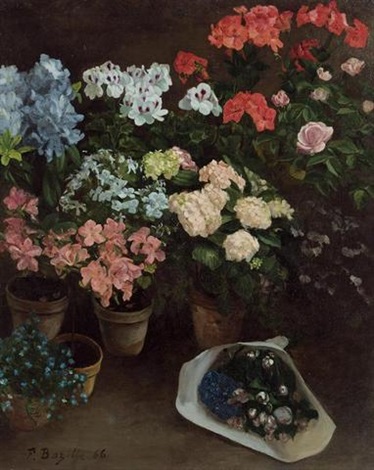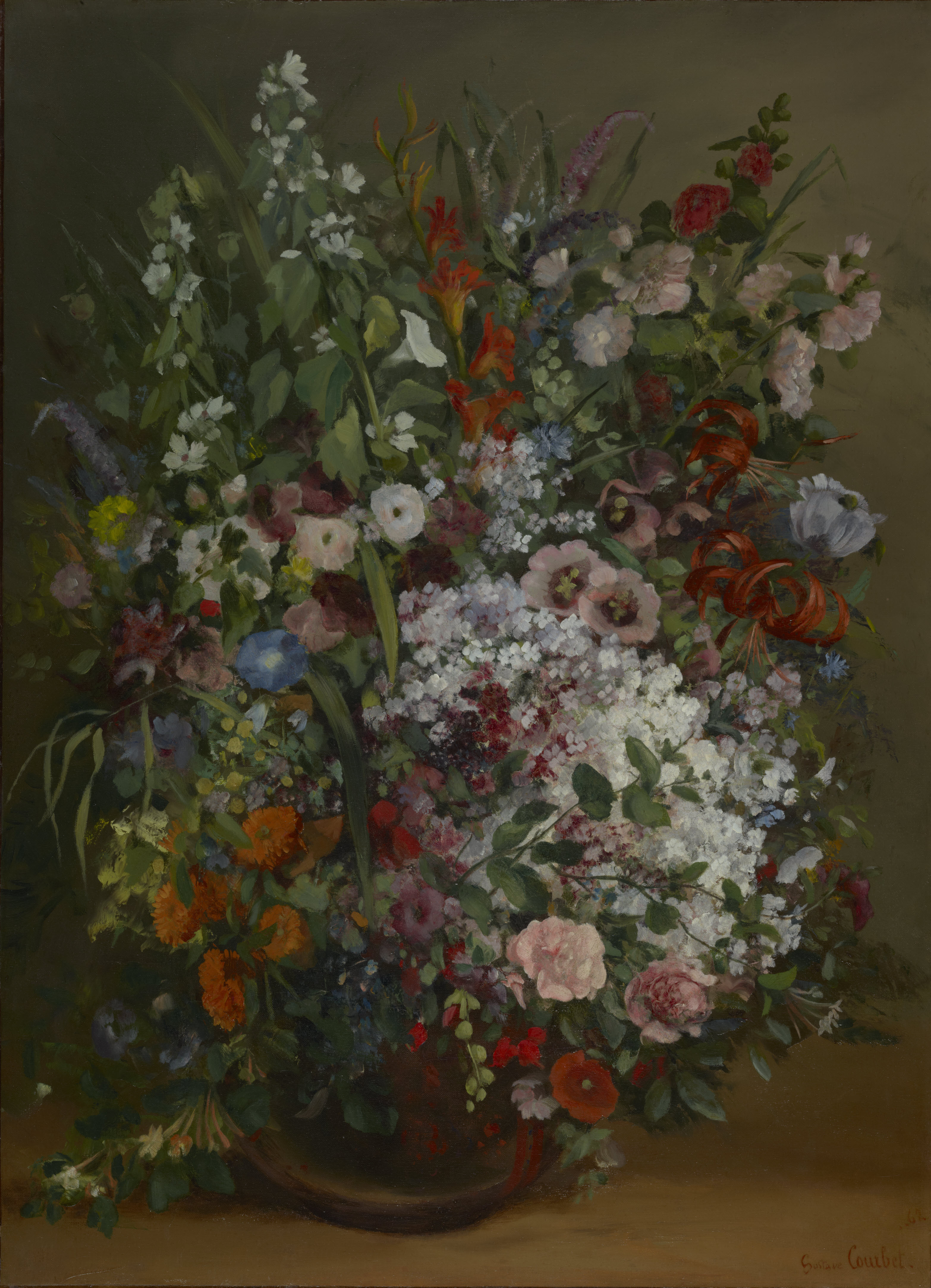From late May 1862 until April 1863, Gustave Courbet spent an intensely productive time in the Saintonge region of southwestern France. There he painted not only landscapes, portraits, nudes, and genre scenes, but also more than twenty flower paintings – his first and only sustained engagement with the genre. Prompting the sojourn was an invitation to stay at the home of the collector Étienne Baudry (1830–1908), whom Courbet had met through his supporter Jules-Antoine Castagnary (1830–1888), an art critic who himself hailed from Saintes, the region’s major town. The eleven months Courbet spent in Saintonge were among the happiest and most fruitful of his entire career. Although he initially planned to stay for only two weeks, the celebrity’s welcome he received, the congeniality of his host and his politically sympathetic Republican friends, the admiration of local painters with whom he joined ranks, the beauty and tranquility of his new work environment, and other pleasurable enticements encouraged Courbet to remain much longer.1
Prior to 1862, Courbet had only painted a small handful of floral still lifes,2 and several factors may have been at play in his turn to the genre in Saintonge. He was likely encouraged by Baudry, an amateur with a passion for flowers who kept greenhouses and extensive gardens on his estate.3 Courbet may also have been prompted by a local commission from a sympathetic Republican lawyer with a taste for floral symbolism, which the artist indulged even though it ran counter to his Realist sensibilities.4 More fundamentally, the market-savvy artist was mindful of the commercial potential of the genre back in Paris, particularly given the recent revival of interest in still life painting and the genre’s old master practitioners.5 Indeed, towards the end of his trip Courbet would frankly admit: “Flowers are making me a mint.”6
One of the larger flower pictures that Courbet painted in the summer of 1862, Bouquet of Flowers in a Vase is an exuberant celebration of natural profusion and vitality. Suggesting a spontaneous gathering of just-picked flowers, the painting cultivates a look of natural informality, repudiating academic formulas in its off-center placement of the simple round pot and the seemingly casual jumble of blooms and grasses that escape its confines and fill the picture plane.
At the same time, Courbet took considerable liberties with nature, freely availing himself of both the most commonplace and the most rare and exotic blooms that he had at hand on Baudry’s estate. Common garden and hedgerow flowers such as honeysuckle, cornflowers, carnations, and marigolds are fancifully intermingled with cultivated hothouse flowers like tiger lilies, hibiscus, firecracker, Madagascar jasmine, and magnolias.7 While most of these are summer-flowering specimens, not all of them are; the spray of lilac near the center, for instance, would have been well past season before the rest of the bouquet was in flower.8 However much Courbet painted directly from nature, the unlikely and extravagant combination of flowers he cultivated here pays homage to the inventive Dutch still-life paintings of the seventeenth and eighteenth centuries.
Whereas his Dutch predecessors labored assiduously over botanical details, Courbet preferred a much more abbreviated, painterly treatment emphasizing decorative effect. With his combined brush and palette knife work, he brought to the genre a new breadth and freedom, displaying here a lightness of touch befitting his subject and marking a departure from the dense physicality that normally characterized his facture, whether he was handling rocks, trees, fruit, animals, or the human figure.
Courbet’s freedom of address and handling was of course a calculated freedom. His cultivated artistry is equally apparent in the painting’s careful weighting and balancing of forms and the harmonious distribution, with an eye to complementary contrast, of the cool whites, blues, and greens and the warm yellows, oranges, vermilions, carmines, purples, and violets.9
Presented against a grey-green background that shades imperceptibly into a brownish foreground and that shifts laterally from light to dark, Courbet’s bouquet ultimately occupies a vague, indeterminate space that is neither wholly outdoors nor indoors – a space situated somewhere between “nature” and “art”, between the artist’s lived experience of the present and the art historical past.10
Courbet first exhibited The Bouquet of Flowers in a Vase in January 1863 as part of a charitable exhibition held in the town hall of Saintes. Featuring nearly fifty of his paintings, including five floral still lifes, the exhibition was a major showcase for the work he had produced in the region over the preceding months.11 The Getty painting was lent to the exhibition by Frédéric Mestreau (1825–1891), a banker and cognac wholesaler in Saintes who shared Courbet’s leftist political sympathies and who, after the defeat of Napoleon III and establishment of the Third Republic, would become prefect of the Charente-Inférieure. Mestreau was a regular guest at Baudry’s country house and he is said to have hosted Courbet on occasion at his residence in Saintes, particularly if the artist had been out late in the brasseries and was ill-disposed for making the trek back to Baudry’s.12
The local press reported enthusiastically on Courbet’s contribution to the exhibition, which was an unprecedented showing of modern painting in Saintes. For commentators like V. Gruet, Courbet’s floral bouquets represented a surprising and welcome new side to his talent: “Who would have believed that there were at the end of his rough painter’s hand fingers light enough to obtain so much finish and delicacy? We are not talking about the vividness of the colors, the vitality, the freshness, the truth: those things are easy for him.”13 Particularly high praise came from critic Pierre Conil (b. 1832), who affirmed Courbet’s status by ranking him among the great still-life masters: “Courbet has conquered his place, as a flower painter, next to the most famous. His Flowers (no. 77), belonging to M. Mestreau, can rival those from the brushes of the Flemish masters Rachel Ruysch, Jan van Huysum, J. de Heem, Veerendael, [and] Abraham Mignon; the Italian masters Domenico Levo, Procaccini, Mezzadio, [and] Zagnani; and the French masters Van Spaendonck, Redouté, [and] M. Saint-Jean.”14 Conil concluded by heartily congratulating Mestreau on his acquisition: “I read somewhere that M. Mestreau paid 600 francs for the painting of which I speak; he could have paid 6000 francs and still made a good deal.”15


After its 1863 exhibition, the painting disappeared from public view. It remained in the Mestreau family’s château de Terrefort near Saintes until the 1960s, after having been published only in 1957 by Roger Bonniot, the foremost authority on Courbet’s Saintonge period.16 Although Courbet’s flower paintings generally found their way into private hands quickly, they did have some reception in Paris in the years immediately following his return from Saintes. Examples could be seen with dealers and in occasional exhibitions, most prominently the large-scale retrospective Courbet mounted to coincide with the Exposition Universelle in 1867.17 By that point, the impact of Courbet’s work could already be measured in the daring garden or greenhouse still lifes of several younger painters who were emerging in the 1860s. It is indeed hard to imagine the flower paintings done that decade by Claude Monet (1840–1926) or Frédéric Bazille (1841–1870) (figs. 1–2) — with their informal, asymmetrical compositions, their bright tones arrayed against neutral backgrounds, and their boldly simplified facture — without Courbet’s vigorous example.18
- Scott C. Allan
-
For exhaustive accounts of Courbet’s Saintonge period, see Roger Bonniot, Gustave Courbet en Saintonge, 1862-1863 (Paris: C. Klincksieck, 1973); and, in an updated and expanded edition, Gustave Courbet en Saintonge: scènes de la vie artistique en province sous le Second Empire (Cozes: La Saintonge Littéraire, 1986). ↩︎
-
Bonniot 1973 (note 1), p. 84. ↩︎
-
Regarding the situation of Baudry’s Chateau de Rochemont, see Ibid., pp. 65–67. ↩︎
-
As Castagnary explained with regard to two overtly allegorical flower paintings Courbet produced, quite against Realist type, early in his stay with Baudry: “at the request of Fédora Gaudin, a lawyer from Saintes and former representative of the people, Courbet made two small paintings of Poppies and Marigolds. I mention them on account of this peculiarity: Gaudin had a mystical bent and he wanted a sort of allegorical picture […]. Courbet, wanting to be agreeable to him, undertook the compositions he requested”(“il fit à la demande d’un avocat de Saintes, ancien représentant du peuple, Fédora Gaudin, deux petits tableaux de Pavots et de Soucis. Je les cite à cause de cette particularité: Gaudin avait alors l’esprit tourné au mysticisme et il voulut une sorte de tableau allégorique et parlant. Courbet, désireux de lui être agréable, lui fit les compositions qu’il demandait”). Cited in Courbet raconté par lui-même et par ses amis, Vol. 1/2 (Geneva: Pierre Cailler, 1948), p. 168; see also Bonniot 1973 (note 1), p. 85. The two allegorical pictures figured among the flower paintings Courbet exhibited in Saintes in 1863; see note 11 below. ↩︎
-
See Petra ten-Doesschate Chu, The Most Arrogant Man in France: Gustave Courbet and the Nineteenth-Century Media Culture (Princeton: Princeton University Press, 2007), pp. 141–42. ↩︎
-
From a letter of April 1863 to Léon Isabey, in Letters of Gustave Courbet, ed. & trans. Petra ten-Doesschate Chu (Chicago and London: The University of Chicago Press, 1992), p. 220 (letter 63–8). ↩︎
-
J. Paul Getty Museum curatorial file: communication from Celia Fisher to Perrin Stein, dated September 26, 1994. ↩︎
-
Ibid. ↩︎
-
For an exhaustive formal analysis, see Roger Bonniot, “Un tableau de fleurs inédit de Gustave Courbet,” Bulletin de la Société de l’histoire de l’art français (1957), pp. 80–87. ↩︎
-
See Rae Becker, in Courbet Reconsidered, exh. cat. Sarah Faunce and Linda Nochlin, eds. (Brooklyn: The Brooklyn Museum, 1988), p. 148, under no. 42. ↩︎
-
The exhibition catalogue lists 43 Courbet paintings; several additional works were added to the exhibition after the opening, making for an estimated total of 47 or 48 works; see Bonniot 1986 (note 1), p. 212. The listed flower paintings included nos. 77 (“Fleurs. Appartient à M. Mestreau”), 78 (“Fleurs, clair de lune”), 86 (“Magnolias”), 93 (“Pavots – légende. La mort triomphe du droit et les pavots endorment les soucis de la vie. Offert à mon ami Gaudin”), 94 (“Soucis – légende. - Les soucis effeuillent les roses de la vie. Offert à mon ami Gaudin”). A picture of a woman arranging flowers on a trellis, now in the Toledo Museum of Art, was also shown (no. 76, “La femme aux fleurs”). See Explication des ouvrages de peinture et de sculpture exposés dans les salles de la Mairie au profit des pauvres. 160 Tableaux signés Corot, Courbet, Auguin, Pradelles (Saintes: Imprimerie d’Alexandre Hus, 1863), pp. 6–7. The remainder of the show was for the most part constituted by the work of local artists Louis-Augustin Auguin and Hippolyte Pradelles, with whom Courbet formed the ephemeral “groupe de Porte-Berteau,” named after a picturesque spot on the banks of the Charente just north of Saintes where the three had painted landscapes in the summer of 1862. ↩︎
-
Bonniot 1957 (note 9), p. 78. ↩︎
-
“Qui aurait cru qu’il y avait au bout de la rude main du peintre des doigts assez légers pour obtenir tant de fini et de délicatesse? Nous ne parlons pas de la vivacité des couleurs, de la sève, de la fraicheur, de la vérité: ce sont choses à lui faciles.” V. Gruet, “Exposition de peinture de Saintes. (Troisième lettre). M. Courbet,” La Gironde (Mar. 3, 1863). ↩︎
-
“Courbet a conquis sa place, comme peintre de fleurs, à côté des plus célèbres. Ses Fleurs (no. 77), appurtenant à M. Mestreau, peuvent rivaliser avec celles sorties des pinceaux de Rachel Ruish, de Jean Van Huysum, de J. de Heem, de Verandael, d'Abraham Mignon, les maîtres flamands; de Domenico Levo, de Procaccini, de Mezzadio, de Zagnani, les maîtres italiens; de Van Spaendonck, de Redouté et de M. Saint-Jean, les maîtres français.” Pierre Conil, “L’Exposition de peinture de Saintes,” Le Courrier des Deux-Charentes (Feb. 12, 1863), p. 5. ↩︎
-
“J’ai lu, quelque part, que M. Mestreau avait payé 600 fr. le tableau dont je parle. Il eût pu le payer 6000F: son marché eût été bon.” Conil 1863, 5. Another journalistic source in 1863 said Mestreau paid 500 francs, while a descendant of the collector later reported, not implausibly, that the picture was a gift from Courbet. See Bonniot 1973 (note 1), p. 230n26. ↩︎
-
See Bonniot 1957 (note 9). ↩︎
-
On the Parisian exposure of Courbet’s flower paintings after his return from Saintonge, see Claude Lapaire, “Gustave Courbet, Fleurs sur un banc,” Genava, n.s., vol. 41 (1993), pp. 216–17. ↩︎
-
On the example of Courbet’s flower paintings for Monet, Bazille, and Renoir, see Jeannene M. Przyblyski, “The Makings of Modern Still Life in the 1860s,” in Impressionist Still Life, exh. cat. Eliza E. Rathbone and George T. M. Shackelford, eds. (Washington, D.C.: The Phillips Collection; with Harry N. Abrams, 2001), p. 30. ↩︎
